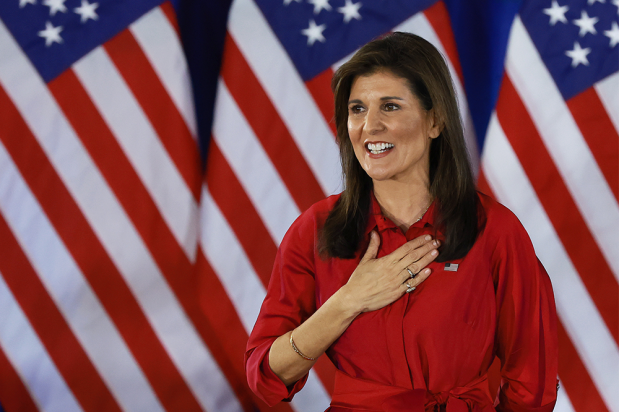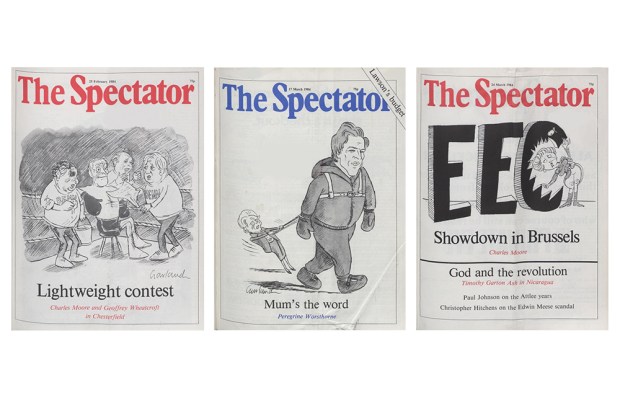You have to give it to Donald Trump: he never stops trying. In a letter dated 25 September, he wrote to our daughter-in-law, who is an American citizen living in Britain (‘United Kingdom Englan’, it said on the envelope) to tell her he was giving her $1,700 under the Coronavirus Aid, Relief and Economic Security Act ‘which I proudly signed into law’. It is a pretty impressive bribe, and it pays out, I believe, to every American who earns less than $50,000 a year. In Hannah’s case, however, it might not work for the President at the coming poll.
In the National Trust’s recent interim report, ‘Addressing our histories of colonialism and historic slavery’, nothing caused more controversy than its unfavourable mention of Winston Churchill, whose country house, Chartwell, it owns. The entry said that the British government’s response to the Bengal famine when he was prime minister was ‘heavily criticised’. It failed to mention that he was fighting Hitler at the time. It also said that he wrote to his successor, Clement Attlee, in 1947, to oppose the independence of India. In my Daily Telegraph column on Tuesday, I pointed out that this latter point was highly misleading, since Churchill supported full self-government for India, but sought dominion status — allegiance to the British crown — along the same lines as self-governing Canada and Australia, rather than formal independence. Since writing, I have noticed other National Trust moves. On 22 September, the Trust’s director of communications, Celia Richardson, tweeted a call for support against the critics: ‘This week a short factual reference to Churchill in a colonial history report led to calls for our 125 year old organisation to be boycotted & defunded.’ The next day, she blogged about this and the need for ‘full and accurate histories of the places in our care’. Beneath her words appeared a sub-head, ‘What do we say about Churchill in the report?’ The answer given is that Churchill ‘was Prime Minister twice, famously during the Second World War — a period that coincided with the Bengal Famine of 1943’. It thus omits the report’s remark that Churchill was ‘heavily criticised’ over the Bengal famine and adds (which the report did not) that the second world war was in progress at the time. It also suppresses (rather than correcting) the report’s misleading claim that he opposed Indian independence in 1947. So the Trust’s summary of its own report is not, to use Ms Richardson’s words, ‘full and accurate’.
I do not think the National Trust is running a covert campaign to discredit Churchill. He was indeed heavily criticised over the Bengal famine. But so was he about Gallipoli, Tonypandy, the Gold Standard, Yalta, and much more — which is exactly what one would expect with a statesman in a 60-year career which included high office in two world wars. The problem is that the Trust has bitten off far more than it can chew. It cannot simultaneously invite people to come and admire the buildings under its care and embark on intense historical controversies, some motivated by the non-scholarly political preoccupations of movements such as Black Lives Matter, about famous people with whom its properties have connections. This is not the job of the world’s greatest heritage organisation. Indeed, it severely compromises that job, because many members naturally suspect that the places they love will no longer be properly cared for if the Trust disapproves of their former occupants. The next bit below Ms Richardson’s blog is entitled ‘How we’re keeping Churchill’s legacy alive’. In a state of confusion, is the accurate answer.
Although the Covid era has not given me the leisure I had been hoping for, I did manage to finish Hilary Mantel’s great Thomas Cromwell trilogy. Having done so, I picked up a once well-known novel by another woman fascinated by the start of the English Reformation. It is The Man on a Donkey, and the author is H.J.M. Prescott. Published in 1952, it concerns the Pilgrimage of Grace — the rising of the north in 1536 against the dissolution of the monasteries and Cromwell and Protestantism (as it was not then known). Although neither Mantel nor Prescott is a polemicist, their sympathies are opposite. Mantel is a cradle Catholic who takes an implicitly anti-Catholic stance. Prescott was the daughter of an Anglican clergyman, but tender towards the old religion. Whereas Mantel sees everything through the eyes of Cromwell (he is physically present for the entire narrative), Prescott observes him coldly as the clever, calculating, rapacious manipulator of Henry VIII’s whim and power. Her hero is Robert Aske, the one-eyed London barrister and Yorkshire gentleman who led the revolt, was fooled by the promises of the King and hanged in a cage from Clifford’s Tower in York.
Mantel’s is the superior, because it is a more sustained and disciplined piece of imagination. (Prescott uses the device of running the ‘chronicles’ of several different characters, but they do not read like chronicles, so the device does not quite work.) But both are outstanding. Prescott may even have the edge over Mantel when dealing with religious matters, since she does seem to believe in holiness and can depict it. Like Mantel, however, she is not easily fooled. Her portrait of the commanding, very Yorkshire, utterly materialistic Prioress of Marrick is one of the best things in the book. If you read Mantel’s trilogy and Prescott’s one (long) volume in succession, you come away with an astonishing picture of that weird period of mental and actual violence which changed England so deeply.
What the two authors share, by the way, is an obsession with the weather. Every day has a meteorological setting as vivid as a landscape painting, which is quite right for an age when people lived by the weather. Now we have half-forgotten weather, and drone on about climate instead.
Got something to add? Join the discussion and comment below.
Get 10 issues for just $10
Subscribe to The Spectator Australia today for the next 10 magazine issues, plus full online access, for just $10.
You might disagree with half of it, but you’ll enjoy reading all of it. Try your first month for free, then just $2 a week for the remainder of your first year.















Comments
Don't miss out
Join the conversation with other Spectator Australia readers. Subscribe to leave a comment.
SUBSCRIBEAlready a subscriber? Log in